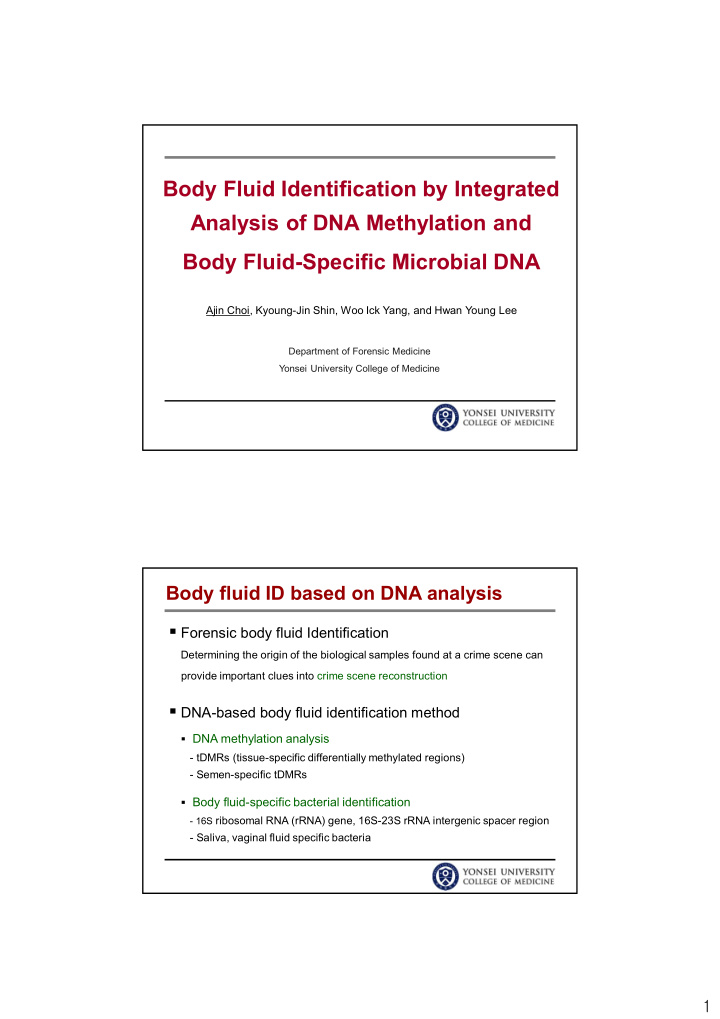



Body Fluid Identification by Integrated Analysis of DNA Methylation and Body Fluid-Specific Microbial DNA Ajin Choi, Kyoung-Jin Shin, Woo Ick Yang, and Hwan Young Lee Department of Forensic Medicine Yonsei University College of Medicine Body fluid ID based on DNA analysis § Forensic body fluid Identification Determining the origin of the biological samples found at a crime scene can provide important clues into crime scene reconstruction § DNA-based body fluid identification method § DNA methylation analysis - tDMRs (tissue-specific differentially methylated regions) - Semen-specific tDMRs § Body fluid-specific bacterial identification - 16S ribosomal RNA (rRNA) gene, 16S-23S rRNA intergenic spacer region - Saliva, vaginal fluid specific bacteria 1
Limitations § DNA methylation analysis - Can clearly identify semen with sperm cells à Imperfect discrimination of detailed body fluids § Body fluid-specific bacterial identification - Can discriminate only saliva and vaginal fluid - Bacteria can reside from body sites that are proximate or can be in contact with the body site à Low specificity è Need to additional markers or integration of other body fluid identification methods for identification of various body fluids in one reaction Objects § Development of multiplex PCR system for efficient body fluid identification by integrated analysis of DNA methy- lation and body fluid-specific microbial DNA § Forensic evaluation of developed multiplex PCR system 2
Experimental Procedures Met DNA extraction & quantification C pG C pG Methylation-sensitive restriction enzyme (MSRE) Treatment Met C pG C pG Template DNA 1 ng, 10 U Hha Ⅰ , 37 ℃ 30 min PCR amplification Enzyme treated DNA 10 ul, Gold Taq 2.0 U, DMSO 5% Fluorescence-labeled primers Thermal cycling PCR product No PCR product 95 ℃ for 11 min, 28 cycles of 94 ℃ for 20 sec, 59 ℃ for 1 min, 72 ℃ for 30 sec 60 ℃ for 60 min Schema of multiplex PCR After MSRE treatment Vaginal fluid-specific bacteria Saliva-specific bacteria 3
Results of multiplex PCR system Blood Saliva Semen Vaginal fluid Menstrual blood Bacteria profiles for each body fluid Number of positive samples Number of Body fluid N negative samples L.crispatus L.gasseri S.salivarius V.atypica Blood 20 0 0 0 0 - Saliva 21 1 0 19 13 2 Semen 21 0 0 0 0 - Vaginal fluid 14 8 9 0 0 1 Menstrual blood 14 8 8 0 0 3 4
Stability test § Aged samples ( environment exposure for 75 days ) showed almost identical results compared with freshly obtained samples Blood Saliva Semen Vaginal fluid Menstrual blood Concluding remarks § The multiplex PCR system, which allows combined use of 4 tDMRs for USP49, DACT1, L81528,PFN3, and 4 body fluid- specific bacteria markers for L.crispatus, L.gasseri, S.salivarius, V.atypica , could be used to discriminate blood, saliva, semen, and vaginal fluid-menstrual blood. § Because developed multiplex system uses the same biological source of DNA for individual identification profiling and simultaneously analyzes various body fluids in one reaction, the method will facilitate more efficient body fluid identification in forensic casework. 5
Thank you for your attention! Yonsei DNA Profiling Group http://forensic.yonsei.ac.kr/ 6
Recommend
More recommend